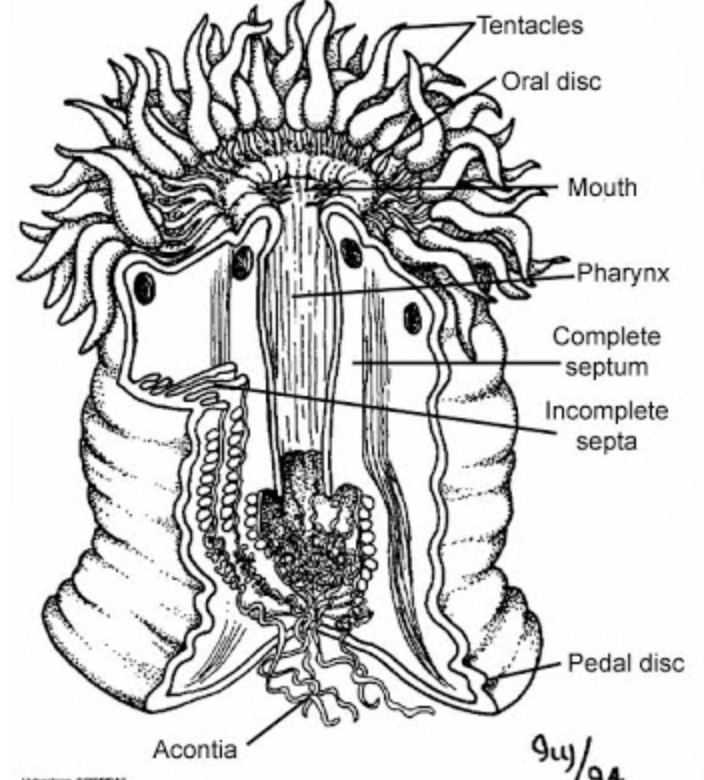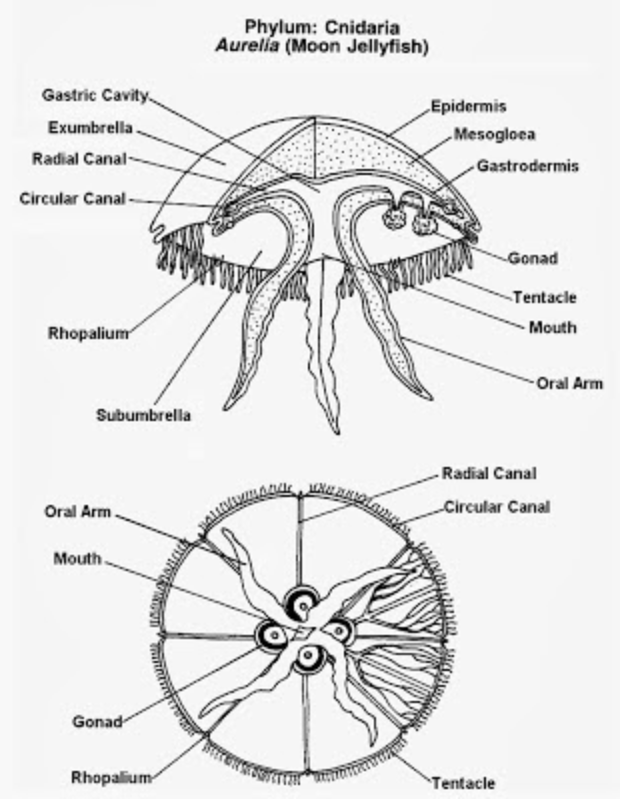Marine Bio Vocab
1/50
There's no tags or description
Looks like no tags are added yet.
Name | Mastery | Learn | Test | Matching | Spaced |
|---|
No study sessions yet.
51 Terms
Porifera
Phylum, Sponges
Cnidaria
Phylum: Sea Anemonies, Sea Jellies, Coral
Polyp

Medusa

Hydrozoa
Class, Hydras
Scyphozoa
Class, Sea jellies
Jellyfish Life Cycle
Planula larva, Polyp, Strobula, Ephyra, Medusa
Staurozoa
Class, Polyps
Cubozoa
Class, Cube Shaped Jellyfish
Anthozoa
Coral, Anemones
Phylum: Platyhelminthes
The flatworms
Phylum: Nemertea
Ribbon worms
Phylum: Nematodes
Roundworms
Phylum: Annelida
Segmented Worms
Class: Turbellaria
free living (not parasites) carnivores, flatworms
Phyla: Mollusca
animals like snails, clams, octopuses, squids, etc
Class: Bivalvia
Hinged between two shells, clams, mussels, oysters, scallops
Class Gastropoda
Body distorted by torsion when there is a shell, Slugs, snails, Nudibranchs, Limpets
Class Cephalopoda
Tentacles and siphon, squids, octopuses, cuttle fish, and the nautilus
Order: Sepiida
Cuttlefish
Order: Octopoda
Octopus
Order: Teuthida
Squid
Order: Nautilida
Nautilus
Phyla Arthropoda
(Joined Foot), Crustaceans, and other arthropods
Class Maxillopoda
(Feed with their Maxillae)
Infraclass: Cirripedia (Curly Foot)
Barnacles
Class Malacostraca
Order: Amphipoda (Two Legs), “Water Fleas”
Order: Decapoda
Shrimp, Lobsters, and Crabs
Class: Merostomata
Horseshoe Crabs
Echinodermata (Spiny Skin)
Sea Stars, Sea Urchins, Sea Cucumbers
Class: Asteroidea
Sea Stars
Class: Ophiurodea
Brittle Stars
Class: Echinoidea
Sea Urchins
Class: Holothurodea
Sea Cucumber
Class: Crinoidea
Feather Stars
Subphylum Urochordata
Sea Squirts, Salps
Subphylum Cephalochordata
Lancelets
Class: Agnatha
Jawless fish, including lampreys and hagfish
Class: Chondrichthyes
Cartilaginous fish, including sharks and rays
Osteichthyes
Bony fish, including salmon and trout
Order Batoidea
A group of cartilaginous fish that includes rays and skates, characterized by flattened bodies and wing-like pectoral fins
Order Chimaera or Chimaeriformes
A group of cartilaginous fish known as ghost sharks, characterized by their elongated bodies, large heads, and unique reproductive methods.
Demersal
Referring to fish that live and feed on or near the bottom of a body of water. Demersal fish often include species such as flounders and catfish, which rely on the benthic environment for food and habitat.
Class Amphibia
A class of cold-blooded vertebrates that includes frogs, toads, and salamanders, characterized by their dual life stages, typically starting in water and transitioning to land. (NO MARINE AMPHIBIANS)
Class Reptilia
A class of cold-blooded vertebrates that includes snakes, lizards, turtles, and crocodilians, characterized by their scaly skin and typically laying eggs on land.
Class Aves
A class of warm-blooded vertebrates that includes birds, characterized by feathers, beaks, and the ability to lay hard-shelled eggs. Most species are capable of flight.
Class Mammalia
A class of warm-blooded vertebrates that includes mammals, characterized by the presence of hair or fur and mammary glands that produce milk for feeding their young. Most give live birth.
Order Carnivora
Polar Bears and Otters
Order Pinnipedia (Pinnipeds)
A group of marine mammals that includes seals, sea lions, and walruses, characterized by their fin-like limbs and a predominantly aquatic lifestyle.
Order Sirenia
A group of marine mammals that includes manatees and dugongs, known for their herbivorous diet and aquatic adaptations, such as a streamlined body and paddle-like flippers.
Order Cetacea
A group of marine mammals that includes whales, dolphins, and porpoises, characterized by their fully aquatic lifestyle and adaptations such as blowholes and echolocation.